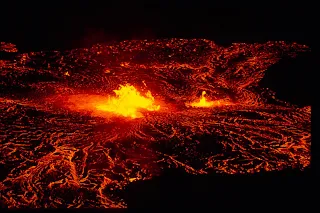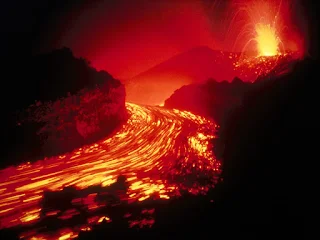Hawaiʻi Volcanoes National Park, established in 1916, is a United States National Park located in the U.S. State of Hawaiʻi on the island of Hawaiʻi. It encompasses two active volcanoes: Kīlauea, one of the world's most active volcanoes, and Mauna Loa, the world's most massive volcano. The park gives scientists insight into the birth of the Hawaiian Islands and ongoing studies into the processes of vulcanism. For visitors, the park offers dramatic volcanic landscapes as well as glimpses of rare flora and fauna.
In recognition of its outstanding natural values, Hawaiʻi Volcanoes National Park was designated as an International Biosphere Reserve in 1980 and a World Heritage Site in 1987. In 2012 the Hawai'i Volcanoes National Park was honored on the 14th quarter of the America the Beautiful Quarters series.
In recognition of its outstanding natural values, Hawaiʻi Volcanoes National Park was designated as an International Biosphere Reserve in 1980 and a World Heritage Site in 1987. In 2012 the Hawai'i Volcanoes National Park was honored on the 14th quarter of the America the Beautiful Quarters series.
The park includes 323,431 acres (505.36 sq mi; 1,308.88 km2) of land. Over half of the park is designated the Hawaii Volcanoes Wilderness area and provides unusual hiking and camping opportunities. The park encompasses diverse environments that range from sea level to the summit of the Earth's most massive active volcano, Mauna Loa at 13,677 feet (4,169 m). Climates range from lush tropical rain forests, to the arid and barren Kaʻū Desert.
The main entrance to the park is from the Hawaii Belt Road. The Chain of Craters Road, as the name implies, leads past several craters from historic eruptions to the coast. It used to continue to another entrance to the park near the town of Kalapana, but that portion is now covered by a lava flow.
The volcano became a tourist attraction in the 1840s, and local businessmen such as Benjamin Pitman and George Lycurgus ran a series of hotels at the rim. Volcano House is the only hotel or restaurant located within the borders of the national park.
Lorrin A. Thurston, grandson of the American missionary Asa Thurston, was one of the driving forces behind the establishment of the park after investing in the hotel from 1891 to 1904. William R. Castle first proposed the idea in 1903. Thurston, who then owned the Honolulu Advertiser newspaper, printed editorials in favor of the park idea. In 1907, the territory of Hawaii paid for fifty members of Congress and their wives to visit Haleakala and Kīlauea. It included a dinner cooked over lava steam vents. In 1908 Thurston entertained Secretary of the Interior James Rudolph Garfield, and in 1909 another congressional delegation. Governor Walter F. Frear proposed a draft bill in 1911 to create "Kilauea National Park" for $50,000. Thurston and local landowner William Herbert Shipman proposed boundaries, but ran into some opposition from ranchers. Thurston printed endorsements from John Muir, Henry Cabot Lodge, and former President Theodore Roosevelt. After several attempts, the legislation introduced by delegate Jonah Kūhiō Kalaniana'ole finally passed to create the park. House Resolution 9525 was signed by Woodrow Wilson on August 1, 1916. It was the 11th National Park in the United States, and the first in a Territory.
Within a few weeks, the National Park Service Organic Act would create the National Park Service to run the system. Originally called "Hawaii National Park", it was split from the Haleakalā National Park on September 22, 1961 (75 Stat. 577) to be formally known as Hawai`i Volcanoes National Park.
An easily accessible lava tube was named for the Thurston family. An undeveloped stretch of the Thurston Lava Tube extends an additional 1,100 ft (340 m) beyond the developed area and dead-ends into the hillside, but it is closed to the general public.
In 2004, an additional 115,788 acres (468.58 km2) of Kahuku Ranch were added to the park, making it 56% larger. This was an area west of the town of Waiʻōhinu and east of Ocean View, the largest land acquisition in Hawaii's history. The land was bought for US$21.9 million from the Samuel Mills Damon Estate, with financing from the Nature Conservancy.
Lorrin A. Thurston, grandson of the American missionary Asa Thurston, was one of the driving forces behind the establishment of the park after investing in the hotel from 1891 to 1904. William R. Castle first proposed the idea in 1903. Thurston, who then owned the Honolulu Advertiser newspaper, printed editorials in favor of the park idea. In 1907, the territory of Hawaii paid for fifty members of Congress and their wives to visit Haleakala and Kīlauea. It included a dinner cooked over lava steam vents. In 1908 Thurston entertained Secretary of the Interior James Rudolph Garfield, and in 1909 another congressional delegation. Governor Walter F. Frear proposed a draft bill in 1911 to create "Kilauea National Park" for $50,000. Thurston and local landowner William Herbert Shipman proposed boundaries, but ran into some opposition from ranchers. Thurston printed endorsements from John Muir, Henry Cabot Lodge, and former President Theodore Roosevelt. After several attempts, the legislation introduced by delegate Jonah Kūhiō Kalaniana'ole finally passed to create the park. House Resolution 9525 was signed by Woodrow Wilson on August 1, 1916. It was the 11th National Park in the United States, and the first in a Territory.
Within a few weeks, the National Park Service Organic Act would create the National Park Service to run the system. Originally called "Hawaii National Park", it was split from the Haleakalā National Park on September 22, 1961 (75 Stat. 577) to be formally known as Hawai`i Volcanoes National Park.
An easily accessible lava tube was named for the Thurston family. An undeveloped stretch of the Thurston Lava Tube extends an additional 1,100 ft (340 m) beyond the developed area and dead-ends into the hillside, but it is closed to the general public.
In 2004, an additional 115,788 acres (468.58 km2) of Kahuku Ranch were added to the park, making it 56% larger. This was an area west of the town of Waiʻōhinu and east of Ocean View, the largest land acquisition in Hawaii's history. The land was bought for US$21.9 million from the Samuel Mills Damon Estate, with financing from the Nature Conservancy.
Several of the National Register of Historic Places listings on the island of Hawaii are located within the park:
- 1790 Footprints
- Ainahou Ranch
- Ainapo Trail
- Kilauea Crater
- Puna-Ka'u Historic District
- Volcano House
- Whitney Seismograph Vault No. 29
- Wilkes Campsite
The Thomas A. Jaggar Museum, located a few miles west on Crater Rim Drive, features more exhibits and a close view of the Kīlauea's active vent Halemaʻumaʻu. The museum is named after scientist Thomas Jaggar, the first director of the Hawaiian Volcano Observatory, which adjoins the museum. The observatory itself is operated by the U.S. Geological Survey and is not open to the public. Bookstores are located in the main visitor center and the Jaggar Museum. The Kilauea Military Camp provides accommodations for U.S. military person.
For more details - Hawaiʻi Volcanoes National Park Official Website

























No comments:
Post a Comment
Stay updated with our blog for more quality content! Your feedback is appreciated. Contact us at harshrex@outlook.com with any suggestions.